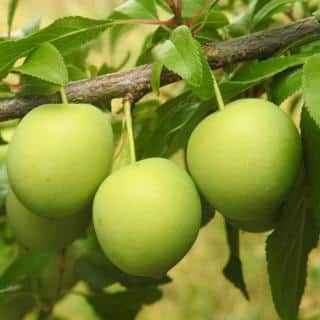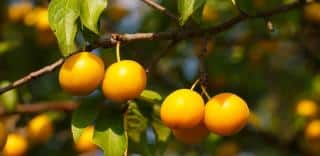

Plum tree is magnificent from spring to fall, and offers abundant harvests of plums.
Name – Prunus domestica
Family – Rosaceae
Type – fruit tree
Height – 16 to 20 feet (5 to 6 m)
Exposure – full sun
Soil – rich enough
Foliage – deciduous
Flowering – March-April
Harvest – July to September
Planting, pruning and care are important to avoid diseases and ensure that your plum trees develop well.
Read also:
Favor planting in fall or in spring but avoid freezing temperatures.
Remember that for all fruit trees, the best period for planting is fall, because this season has the highest success rate for root development in spring.
For a plum tree, pruning fulfills two functions: caring for the tree itself, and enhancing fruit harvest.
It’s recommended to prune only what is strictly necessary because plum trees are delicate and wounds make it vulnerable to diseases.
After each cut, apply pruning paste like pine tar to protect the wood from fungus and other diseases.
Nonetheless, you may perform directional pruning in the first year to shape the structure of the tree.
Maintenance pruning is performed in winter but not during freezing weather.
After pruning, using pruning paste helps avoid infection due to fungus and diseases.
Plum trees, like most fruit trees, are vulnerable to multiple diseases and parasites.
Again, aphids are the plum tree’s most common enemy. Here is how to fight aphids efficiently.
As a deterrent against aphids, several organic treatments are available such as spraying fermented stinging nettle tea or fermented horsetail tea. Both help reinforce the plum tree’s defense mechanisms and also help it avoid certain types of fungus.
Also, if fungus such as plum rot (European brown rot) or rust appear, there are specific treatments that can be applied.

When purchasing plum trees, try to select varieties that are adapted to your local climate. This will guarantee that you will have a great harvest at the right time.
It is important to not let the fruit ripen for too long on the tree because it starts rotting and falls to the ground.
Sadly, it is very difficult to keep plums for very long. That’s why it is often recommended to eat them quickly.
Plum trees are fruit trees, and their fruits are both eaten fresh as plums or preserved in various manners such as jams, liquor, pastries or simply desiccated as dried prunes are, a specialty in the French region of Agen.
Plum trees are also grown as ornamental plants since their blooming is generous at the beginning of spring and their foliage stays appealing until the leaves fall off.
Fruit-bearing will be greatly enhanced if manure is added at the base of the tree in fall, and if fruit tree fertilizer is added in spring.
All plum trees, be they ‘Mirabelles’, ‘Damsons’, ‘Valor’, ‘Miraclaude’ or ‘Thames Cross’, give fleshy fruits with high vitamin C, calcium, and mineral content.

The plum used to prepare the famed Agen dried prune is the ‘Prune d’Ente‘.
Mix different varieties in order to enhance pollination and hence productivity. This is called cross-pollination.
If you only plant one plum tree, choose a self-pollinating variety such as ‘Prune d’Ente’, ‘Mirabelles’ or ‘Damsons’.
<!–silent
–>
Mulch the foot of the trunk to avoid weeds, protect roots from the cold during winter and retain moisture in the summer.
hello can you please help. The year of 2018 we had a abundance of plums but the following year 2019 our tree didn’t fruit much and we noticed most of the leaves where curled. This year our tree looks healthy but some branches have leaf curl again we don’t want to have the same experience as last year. What do we need to do to have a good harvest
Oh, my, it’s always difficult to get rid of leaf curl. There’s still a small chance to salvage some of the harvest by spraying Bordeaux mix and removing infected leaves. However, the overall goal is to keep the fungus from reappearing next year. Read this page on treating leaf curl (peach and plum leaf curl are the same).
Why are certain branches on my 4 year old plum tree dying?
Hi Ken! It took me a day or two, but I believe that what your tree is showing is either of the following:
– At first glance, it may simply be the remnants of last year’s deep freezing. Wounds seem dry and one can see in some places that last year’s growth has started to cover over exposed wood. Some of the twigs seem to have died last year already, and since you’re paying more attention this year, they stand out.
– however, it may also be canker. Canker is a fungal disease. If the wounds start blackening, spreading, or weeping sap and fluids, it’s definitely canker. It doesn’t mean that your tree is condemned, but there are a few steps to take to protect your tree. Read here on how to deal with canker.
In both cases, I would recommend the following:
– Spray Bordeaux mixture on your tree at least 3 times at two-week intervals. You can also prepare your own horsetail tea or other fungicidal fermented teas and use it in the same manner instead. Drench the tree totally, but avoid the inside of the flowers if you can to still permit fertilizing.
– Wait until mid-summer to prune off dead or sick wood. Don’t prune now in spring as the season is rather wet. Wet weather is a boon for fungus. Cutting back to healthy wood in summer ensures the tree has time to cure and heal its wounds before autumn. Burn diseases trimmings in your fireplace or garden fire pit.
– About the larger branch that is decaying. It seems no buds are sprouting from that large branch, so it won’t draw sap. Unless I’m mistaken, it is dead. Cut it off cleanly with a disinfected saw and whittle the bark around the saw cut somewhat to speed healing.
I’m sure your tree will recover. It’s still young and vigorous. See the new growth near where the large branches meet the trunk? In time, select the most vigorous one, remove any others with clean shears. This can become a new structural branch within a few years.
Hope this helps!
Hello Rayan! The only occasion for which picking fallen fruits up is really recommended is if ever your plums are really infested with pests like flies or with diseases like rot. Leaving the contaminated fruits on the ground would breed problems for the following season. But you only need to do this if you tree is really infested. Having only a handful of “sick” fruits decomposing shouldn’t be much of a problem, but keep an eye out just in case.
You might have a few plums sprout in spring, which you can either mow down or transplant. There’s always uncertainty about the fruit quality when sprouting from seed, could be delicious or just random normal.
In any case, the decomposing materials will attract all sorts of garden animals, like birds and bugs and it increases overall soil quality. If you would like to prepare rich compost, gather them in an old barrel or trash bin or whatever you can make holes at the bottom to, and come spring you’ll have thick, black compost with what’s left (and more than a few pits thrown in).
If you can go around the tree daily or twice a day, many of the newly fallen fruits will still be perfect for eating or making preserves, like jam and such!
Do I need to pick up all the plums on the ground under my plum trees?